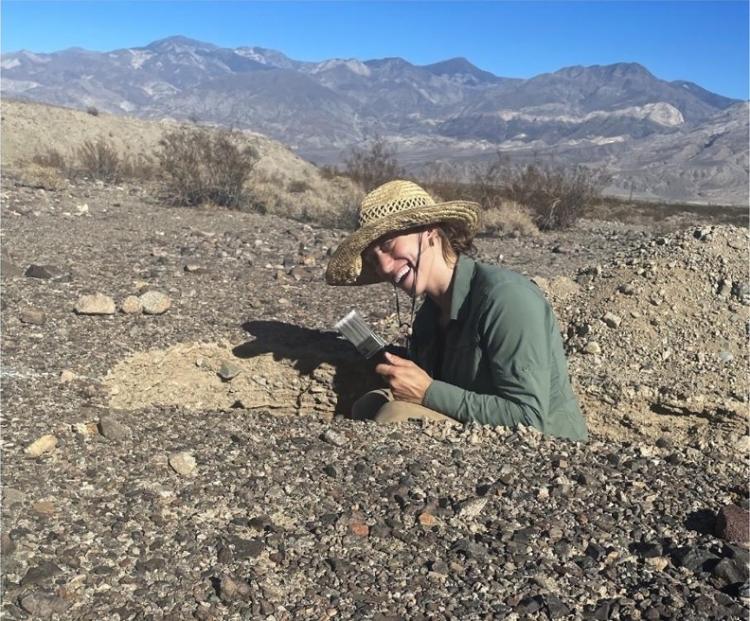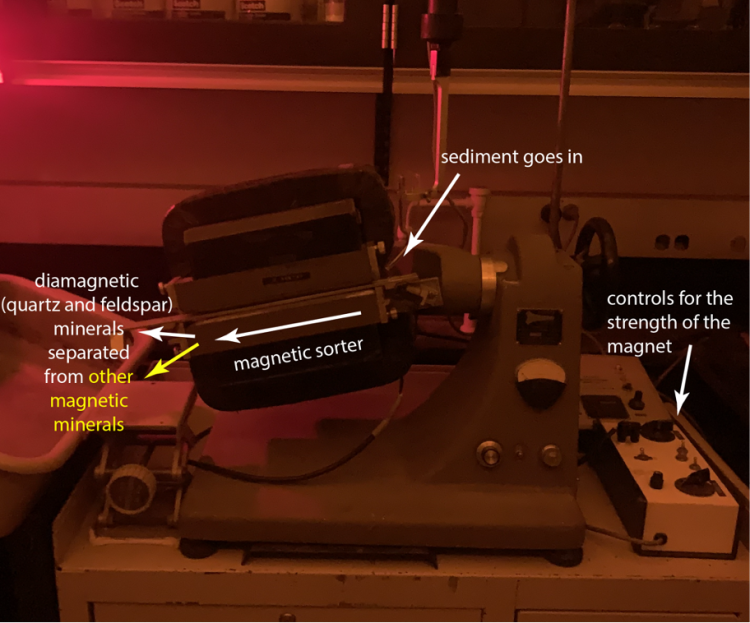Aubrey LaPlante - Project Profile
2021 AGeS awardee
Lab: USGS Luminescence Lab
Lab Mentors: Shannon Mahan, Harrison Gray and Emma Krolczyk

Figure 1: Cleaning and illustrating a stratigraphic section in a soil pit to interpret the depositional process associated with this alluvial fan. I targeted fluvial deposits that would have reset a feldspar grain during transport, reducing the amount of inheritance that could product an artificially old age.
What scientific question(s) does your research address and what motivates this work?
Hazardous multi-fault ruptures, such as the 1992 Landers earthquake, the 1999 Hector Mine earthquake, and the 2019 Ridgecrest earthquake sequence, have been observed in southeastern California within the last ~30 years. Characterizing seismic hazard for multi-fault ruptures, or fault systems that promote slip to jump from one fault to another, requires knowing the fault geometries, kinematics and timing of paleoseismic earthquakes on these faults. For my study I targeted the Ash Hill and Panamint faults in Panamint Valley, CA, which have previously been proposed to host paleoseismic multi-fault ruptures during the Holocene. Using the funds from this grant, I bracketed the timing of paleoseismic earthquakes in the 10 km-wide transtensional relay between these fault systems using feldspar infrared-stimulated luminescence (IRSL) to date offset late Holocene alluvial fans. Using these ages, I hope to provide evidence for coordinated rupture between the Ash Hill and Panamint faults during the Holocene.
What chronometric tool did you employ and why?
I used feldspar infrared-stimulated luminescence (IRSL) to date the last exposure of an alluvial deposit to sunlight. The ages from each sample provided the approximate age when the alluvium was deposited and subsequently abandoned by the paleochannel. To bracket earthquake timing, I dated deposits that were offset by faults to provide maximum ages, and undeformed, inset deposits to provide minimum ages of rupture. Since Panamint Valley is in an arid climate, woody vegetation does not thrive there and finding deposits for C14 dating is challenging. Other studies have used quartz optically-stimulated luminescence (OSL) to date Quaternary alluvium in eastern California, however, quartz in the Mojave region does not luminescence well.

Figure 2: Shown above is my favorite machine in the luminescence lab. This Frantz isodynamic magnetic separator (Model L-1) separates minerals by magnetic properties. I funneled sand-sized grains through the Frantz machine twice, with increasing magnetic field strength, to separate the quartz and feldspars from any other types of magnetic grains.
What were some of the key takeaways of your research?
- Feldspar IRSL ages were consistent with my initial assessment of deposit age, interpreted from a relative-age alluvial chronology based on changes in surface morphologies that we generated for Panamint Valley.
- Bracketing ages of earthquakes in the Panamint Valley transtensional relay overlap with the timing of earthquakes on the Ash Hill and Panamint faults.
- Preliminary analysis suggests that the Ash Hill and Panamint faults may be transferring strain through the 10 km-wide transtensional relay between these fault systems, leading to coordinated ruptures.
What new experiences, opportunities, and collaborations did you gain as an AGeS-Grad awardee?
My experience in the USGS Luminescence Lab provided me with hands on experience in the preprocessing stages of luminescence sample preparation. I believe these types of experiences are invaluable. Not only was I able to learn how these samples are processed and interpreted, but I learned 1) how I may be able to procure a better sample in the future and 2) how to interpret the age results given the uncertainty inherent in each sample and sample location. I love that I can write my methods from my experiences and not just from other papers who have used the same methods.
Additionally, I loved the connections this program provided for me. In the age of COVID, when the only professional connections I was making was in small school-oriented research groups, this program connected me with Shannon and Harrison and Emma. I was able to see the multitude of ways luminescence can be used in other types of research. Everyone at the USGS Luminescence lab was so incredibly helpful and supportive from start to finish. Shannon and Emma even came into the field with me to discuss my research and see my field area!
What is one piece of advice you have for future AGeS-Grad award applicants or awardees?
My biggest piece of advice for AGeS-Grad applicants/awardees is to schedule a meeting with the lab prior to sample collection to gain advice from the people who work directly with the samples on how to acquire the best possible sample for your specific research question. Every lab is slightly different, so if you can understand what your lab prioritizes, it makes the sampling and analysis much easier.

